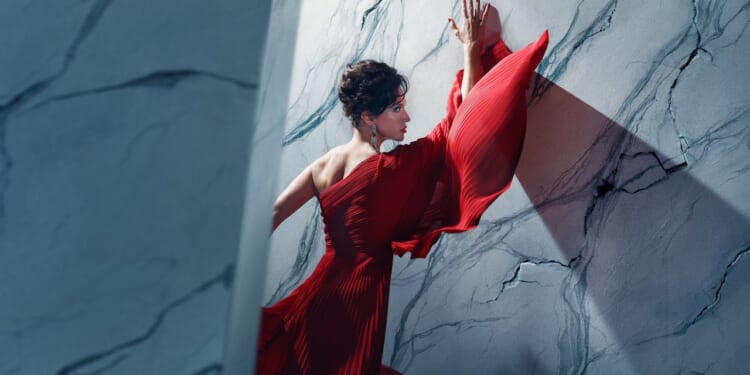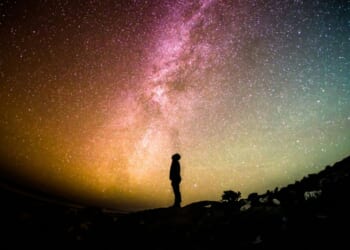Spasimi d’ira, spasimi d’amore,” exults Baron Scarpia, Rome’s villainous police chief, as he browbeats the terrified singer Floria Tosca into agreeing to a night of passion to save her condemned lover, the revolutionary painter Cavaradossi, from execution. Scarpia’s dry irony suggests that his victim’s pangs of love are indistinguishable from her flashes of anger. This excites Scarpia’s twisted sensibilities, but a graver view of the sentiment surrounded Oliver Mears’s new production of Puccini’s opera, which opened the Royal Opera’s 2025–26 season. London’s new Tosca saw the return of the controversial Russian superstar soprano Anna Netrebko after a six-year absence. It also marked the appointment of the talented Czech conductor Jakub Hruša as the company’s next music director.
Netrebko’s return sparked much controversy. Across the Anglosphere, and occasionally in other places, she has been proscribed from the stage for several years. Her supposed sin was failing to denounce Vladimir Putin. To be clear, Netrebko has repeatedly denounced the Russian invasion of Ukraine. That is a crime in Russia, where, ironically, Netrebko can also no longer perform. Most European houses understand her predicament, and her career has thrived on the Continent, while other companies, including New York’s Metropolitan Opera, have noticeably suffered without her. News of her return to Covent Garden provoked denunciations from Ukrainian and British artists, a handful of parliamentarians, and, for some reason, Helen Clark, a former New Zealand prime minister. To its great credit, the Royal Opera was undeterred by these detractors and by a demonstration outside the theater. By the second night, when I attended, the protest had dwindled to just ten people whom the sold-out London audience saw fit to ignore.
Perhaps the greatest answer to the critics came in the waves of cheers that greeted the world’s greatest living singer after she performed “Vissi d’arte,” Tosca’s signature aria. In the context of the opera, Tosca is asking God why he has inflicted such a cruel fate upon her after a virtuous life dedicated to art. But for Netrebko, the sentiment palpably transcended Scarpia’s machinations. In the aria, and throughout the evening, she sang with her customarily voluptuous, full-bodied soprano, which remains unparalleled in passion and dramatic power. Having heard her in the part before the war in Ukraine, I hope she will forgive me saying that after and perhaps because of her tribulations, she may sound even better now.
Netrebko was admirably partnered by the young Italo-British tenor Freddie De Tommaso, whose Cavaradossi has grown on audiences on both sides of the Atlantic. He has a big, brash voice that lends itself perfectly to the character’s pride but that also convincingly delivers the rapturous meditations on his love for life and romance in his Act III aria “E lucevan le stelle.” Gerald Finley, a stalwart Canadian baritone, has come a long way since his more lyrical days in Mozart roles. His darker and heavier late-career voice, with which he tackled Wagnerian and other more strenuous parts, is well suited to Scarpia, here exuding less the character’s usual aristocratic bravado, and more a repressed bureaucrat’s gnawing sexual frustration.
Mears has updated Tosca from its Napoleonic setting to a late-twentieth-century police state. The concept draws from the cinematic depictions of Rome by the Italian realist school, best exemplified in the films of Roberto Rossellini, Federico Fellini, and, more recently, Paolo Sorrentino, which juxtaposed the daily annoyances of urban life against the grandeur of its historical landscapes. Ilona Karas’s costumes suggest a 1980s demimonde confronting oppressive officialdom. Tosca enters in movie-star sunglasses and a chic summer dress worthy of vintage Versace. Scarpia sports a stuffy three-piece suit in the unfortunate beige hue popular in the 1980s, together with a broadly knotted tie and heavy wristwatch. Bureaucrats reminiscent of extras in Goodfellas are present throughout.
Simon Lima Holdsworth’s sets eschew the familiar Roman landmarks in favor of starker stylings. The traditional setting of Act I in the Church (now Basilica) of Sant’Andrea della Valle is transferred to the Church of Sant’Ivo alla Sapienza, which Holdsworth found easier to adapt from its distinctively rounded Baroque architecture to a state of ruin caused by the depredations of modern authoritarianism. Puccini’s magnificent “Te Deum,” the prayer service that ends the first act in a mélange of religious fervor, political domination, and Scarpia’s lust, unfolds as a battle in progress. The parishioners are refugees, and the ambient cannon shots that indicate the escape of the republican prisoner Angelotti, whom Cavaradossi illicitly aids, here become live fire bombarding the church. Is Mears trying to tell us that Christianity is under assault in contemporary Europe, even as his own country grapples with a mass-migration crisis?
The usual setting of Act II, the High Renaissance Palazzo Farnese, today the French embassy in Rome, is unveiled here as a vast marble monument of officialdom, at once overwhelming and depersonalizing. Scarpia slurps his “povera cena” out of a tinfoil takeout container and washes it down with swigs from a wine bottle. Mears intelligently keeps Cavaradossi’s torture scene offstage, as Puccini intended, to focus our attention on Tosca’s horrified reaction to his pain and her predicament. After signaling that she will give into Scarpia’s lust, however, she bashes his head with a heavy ashtray and stabs him in the neck with a hairpin. She pauses to cast Scarpia’s jacket over his lifeless face, but the usual sentimentality that accompanies her expression of forgiveness goes by the wayside as she stalks out in an agitated state. The murder’s psychological dimensions are explored well, but we also learn a great deal about the abusive powers of the bureaucratic state, another topical trope in the United Kingdom these days.
The lesson continues in Act III, where the Castel Sant’Angelo, the ancient Roman imperial tomb turned papal fortress turned prison, is reduced to a sterile execution chamber. The act’s orchestral prelude accompanies a pantomime execution of another prisoner, who is done away with by a bullet to the head after humdrum formalities. Cavaradossi’s mock execution, which turns out, in a final act of Scarpia’s spite, to be real, unfolds in a near-repetition of the preceding scene. Facing capture by Scarpia’s henchmen, Tosca does not jump from a parapet but shatters a window with a chair and plunges to her death through the opening.
Hruša displayed an absolute mastery of Puccini’s score, which moves at an enthralling pace and leaves little room for pause. In those few subtle moments of reflection, however, he enlivened every note and every instrumental solo to uplift the larger whole. Under the superb direction of William Spaulding, the Royal Opera Chorus populated Mears’s embattled Rome with denizens whose various fates capture the Eternal City in turmoil. Traditionalists may howl, but this production, which replaces Jonathan Kent’s classical staging of the opera after nearly two decades of frequent revivals, will stand for a long time.

















